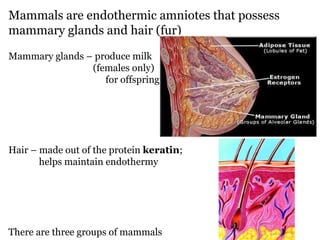Report
Share

Recommended
Recommended
More Related Content
Viewers also liked
Viewers also liked (20)
More from Stacy Baker
More from Stacy Baker (20)
Phylum Chordata - Class Reptilia, Aves, and Mammalia

Phylum Chordata - Class Reptilia, Aves, and Mammalia
Phylum Chordata - Class Mammalia
- 1. Mammals are endothermic amniotes that possess mammary glands and hair (fur) Mammary glands – produce milk (females only) for offspring Hair – made out of the protein keratin ; helps maintain endothermy There are three groups of mammals
- 2. While most mammals give birth to young, the monotremes are egg-laying mammals
- 3. Marsupials – pouched mammals that give birth to undeveloped embryos that then develop inside a pouch
- 4. Placental mammals – embryo develops inside the mother’s uterus where an organ called the placenta provides the embryo with nutrients and oxygen and removes waste products
